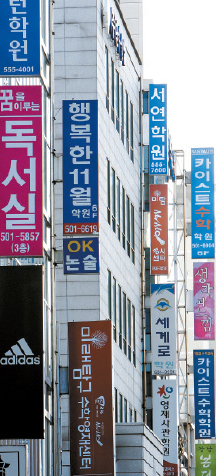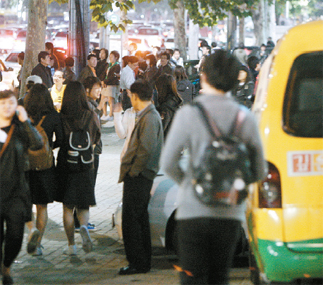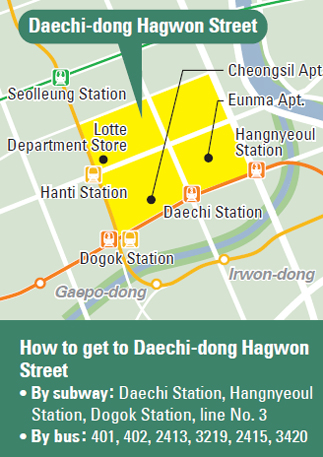Downturn hasn’t hurt Seoul’s hagwon haven

Many signboards, left, of hagwons adorn the buildings in Daechi-dong, southern Seoul.
“It’s been more than two years since I’ve been driving my daughter to and from hagwons here,” said Choi Yoo-mi, a devoted mother who looked to be in her 40s, as she waited on her high school freshman. She had temporarily parked her car in the bus lane.
“I used to pick up my daughter later at night, at around 11, but with the government’s recent ban on preventing private institutions from providing classes after 10, all sessions have to end at around this time,” she said.
In a bid to help reduce the financial burden on families who often pay mega-bucks for their children’s private educations, the Education Ministry in July announced that hagwons are prohibited from teaching late at night.
Ever since, officials from the Seoul Gangnam District Office of Education have been going around the area and checking to see whether the hagwons are abiding by the new regulation and ending classes on time.
A group of students, parents and private institute owners filed a petition against the new policy, but the Constitutional Court ruled last week that the ban is constitutional.
Nevertheless, Kim Ja-yeon, another mother who was waiting for her teenage son, said that “the ban would only trigger more competition because students are sent to hagwons in other areas outside Seoul like in Gyeonggi and continue their studying there after midnight.”
As buses and cars lined up behind the two mothers began honking their horns, the atmosphere surrounding the exits of Daechi Station on line No. 3 seemed tense, especially with the annual national university entrance exams less than two weeks away.
“Now is the busiest, most sensitive period of the year for institutions located here,” said Lee Hyo-jun from Megastudy, an educational services provider that operates a branch in Daechi-dong. “The tension is even higher in the Daechi-dong area, where small and large private academies are clustered.”
According to the education office, of the 2,840 hagwons in the whole of Gangnam, more than 400 hagwons are currently located in the Daechi-dong area alone, making it the largest mecca for private institutes in Seoul. Despite the recent bad economy, “the number of hagwons opening keeps on growing,” said Song Ki-cheol, an official from the district office.

With the national college entrance exam less than two weeks away, students, Mostly in school uniforms walk down hagwon street in Daechi-dong on Friday. There are more than 400 hagwons clustered in the area. By Oh Sang-min
In fact, a recent survey by the Bank of Korea and the National Statistical Office showed that the gap is growing between hagwon expenditures by the top 20 percent of households, mainly in southern Seoul, and those of households in northern Seoul.
“In areas in northern Seoul, when the economy is bad, hagwons close down and new ones don’t open in their place,” said Kim, a teacher at one of the hagwons near Eunma Apartment who did not wish to be named. “But here, though there are some institutes that close down after failing to compete with other hagwon in the neighborhood, there are as many new ones opening.”
So, why is it that hagwons located here are so prosperous and well-off compared with others around Seoul?
“The [Daechi-dong] area is a relatively good location for private institutions because there are a number of elite schools nearby and many apartment complexes,” said Kim Jin-ho from Seojin Hagwon.
Stepping out of Daechi Station, each of the eight exits leads to different apartment complexes, including the Eunma, Mido and Woosung apartments.
Kim also said that there are hardly any entertainment spots and that most buildings here have less floors compared with others in the southern Seoul areas.
“In Daechi-dong, there isn’t a building that is higher than 10 stories,” he said, noting that most are five to six stories high. “It’s relatively easy for a hagwon to open since it is more convenient for them to advertise using signboards.”
Though the exact year that the hagwon hot spot was established is unclear, industry experts point to a probable start in 1987.
Back then, the government lifted a ban on hagwons and allowed students to enroll in private institutions. For years, parents complained that the cost of private tutoring was excessively high and demanded that hagwons be allowed to open. Officials took note of the complaint and students were soon allowed to go to the private institutes.

The trend today, however, is that “parents prefer sending their children to small, private hagwons instead of the larger ones,” Kim said.
“It’s normally the case that well-known brands are popular elsewhere but not here in Daechi-dong,” said a principal from a small hagwon who asked to remain unnamed. “Also, there is a tendency that more expensive hagwons attract parents because they think that cheaper ones are low in quality.”
The principle said that that’s why hagwons here are raising fees.
“Parents here want their children to be raised as socially elite intellectuals rather than to be rich or successful,” said Kim, a teacher from a well-known Korean language hagwon in Daechi 4-dong. “Parents ask teachers for classes that are well-suited to their children rather than lectures that are for the masses. An increasing number of parents are wanting more from hagwons. For example, they want us to teach students to improve their creativity.”
The teacher said that if hagwons cannot meet those parent demands, they cannot survive.
By Lee Eun-joo [angie@joongang.co.kr]










with the Korea JoongAng Daily
To write comments, please log in to one of the accounts.
Standards Board Policy (0/250자)